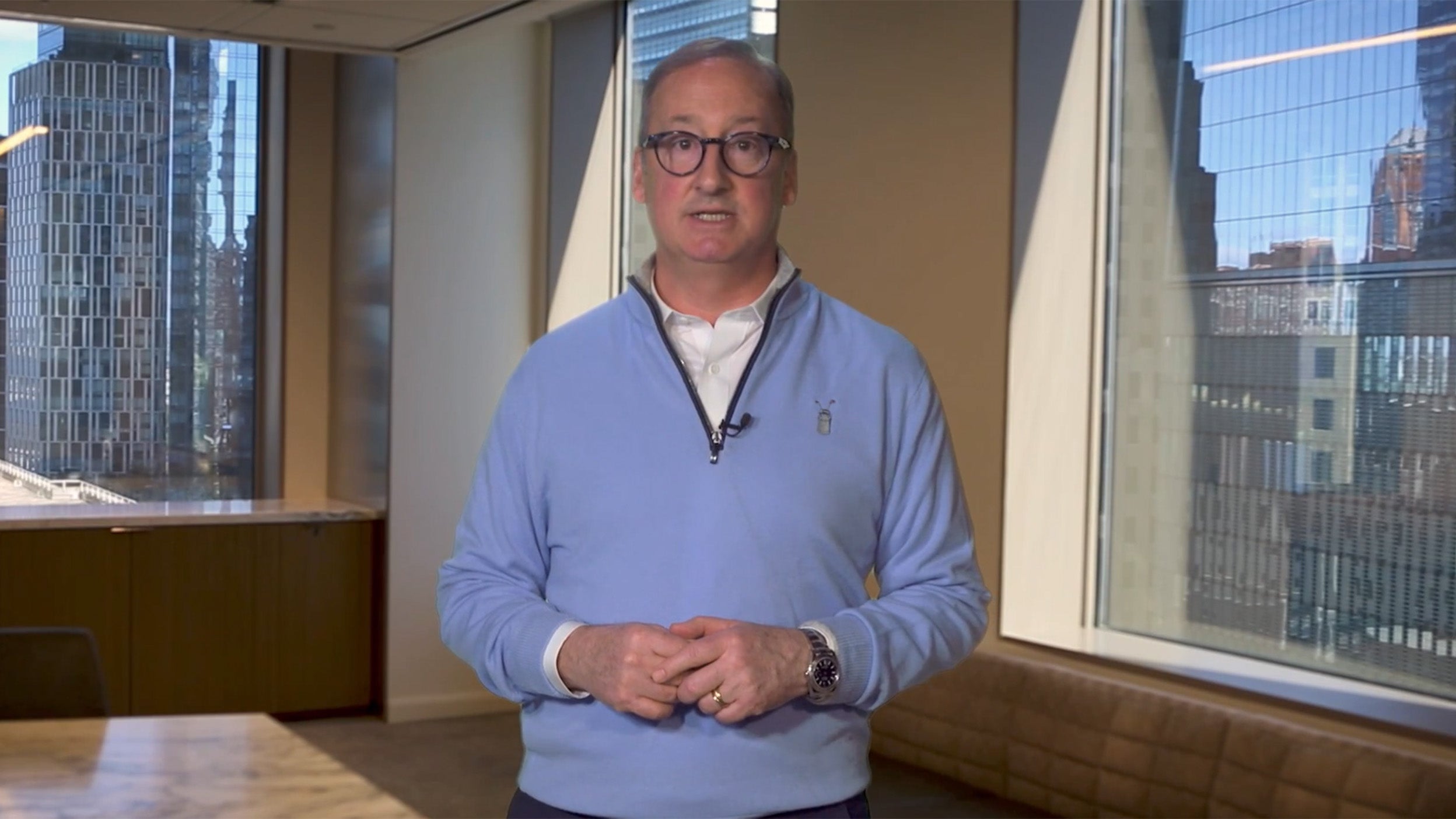
Record quarter sees ETF investors shift their focus towards Europe
The European ETF market had its best quarter in terms of flows. Read the latest to find out more.

Thematic ETFs are an evolution of traditional sector exposures, aiming to capture opportunities tied to a specific theme regardless of sector classifications.
Themes should be broad enough to gain diversified exposure but targeted enough to capture the true potential of the theme, plus have long-term growth prospects.
Thematic ETFs can provide investors with the tools to tilt their portfolios to selected growth areas, with examples including AI, cybersecurity, defence and blockchain.
Although thematic funds have been around for many decades, passive exposure via ETFs is a more recent development. A wide variety of thematic ETFs are now available but, with so much choice, how can you identify those with the greatest potential? It’s important for investors to understand what a thematic ETF aims to achieve, how to include them in a diversified portfolio, and be able to distinguish between genuine long-term investment opportunities and what may simply be interesting ideas based largely on hype and hope.
Thematics are an intelligent evolution of the traditional sector approach and can be used strategically or tactically in much the same way as sector ETFs. As an investor, you can expect thematic ETFs to have lower correlation with – and more short-term volatility – than broader equity exposures, and so it’s sensible to expect the potential for greater returns than broad equities over the longer term. That risk-return trade-off can be beneficial for diversification.
The biggest difference between thematic and sector ETFs is that sector ETFs group companies together by specific fields of business activity, while thematic ETFs seek to identify companies that are involved in a specific theme or global trend irrespective of their economic sector. A theme is often associated with disruptive technologies, such as clean energy, blockchain, robotics or other technological innovations.
When considering any theme, some of the questions an investor might want to ask include:
Thematic investments were once almost exclusively the domain of actively managed funds, but increased investor demand saw passively managed ETFs tracking new thematic indices gain popularity. There are now more than 200 thematic ETFs available in Europe with combined assets of more than $50 billion1. These thematic indices were typically created by specialist firms, sometimes in consultation with an ETF manager to ensure the index satisfied investor needs.
As this segment of the ETF industry grew, larger index houses either developed in-house capabilities or acquired these specialist firms. Today, many of the thematic ETFs in Europe follow indices that are constructed by the specialist arm of a large index house, which provides both expertise in the subject matter and a long robust history in the administration of indices.
Artificial intelligence (AI) has already made an important contribution to investing, including in the construction of thematic ETFs. Because these ETFs follow indices designed to select stocks based on characteristics other than sector classification, an index provider needs an efficient way to screen the universe of stocks for those meeting the theme’s definition.
Natural language processing (NLP), machine learning (ML) and other sophisticated AI technologies can be used to quickly and objectively search through thousands or potentially millions of corporate documents and communications to flag occurrences of relevant key words and phrases to identify potential candidates for inclusion in that theme.
The use of these technologies offers a powerful complement to more traditional subject-matter-led approaches to identifying thematic exposures and some strategies look to combine both.
The use of AI in index construction is just one example of the potential for the technology. Experts expect there to be examples of companies in most industries incorporating some form of AI into their products, services and business activities. This enormous growth potential makes AI a good case study for what makes a good theme from an investment perspective.
AI-enabled applications are predicted to contribute potentially US$15.7 trillion to the global economy by 20302. The largest part of this market is expected to be NLP followed by ML, with other potential growth areas including AI-enabled robotics and automation, and generative AI. Demand is being driven by the desire for greater efficiency and productivity from data-intensive devices that are such a critical part of our daily lives.
The concepts underpinning today’s AI date back to at least the 1950s, when scientists, mathematicians and even the Hollywood industry envisioned the potential for machines to formulate ideas. However, AI began taking shape in the ‘90s and has gathered pace more recently with more scalable applications. NVIDIA dominates the specialist chip market that is fundamental to the growth in AI-enabled applications, but the broader AI space includes more than enough diversity to construct indices, from broad to more specifically focused exposures.
Cyber Security is a theme growing in importance, partly due to the success of AI. Cyber crime is one of the most advanced threats that anyone connected to the internet faces today and is predicted to cost US$12 trillion by 20253. The rising threat is due to more sophisticated cyber criminals using AI to make their attack more convincing through deepfake and other tactics. Companies that make the internet and mobile communications more secure should be in high demand, with growing sources of revenue, for decades to come.
The defence industry, unfortunately, is also seeing growing demand as threats intensify around the world. Technological innovation is reshaping defence strategies, with unmanned drones reducing the need for soldiers to be in harm’s way on the front line. Other innovations will hopefully act as deterrents for future conflict and, in so doing, make the world safer.
We have launched two thematic ETFs that will follow innovative benchmarks constructed by Kensho, an arm of S&P Global Indices with expertise in the employment of AI technologies. NLP and ML are used to screen a global universe of stocks to identify those with potential associated with the theme, and Kensho’s analysts further review the stocks to qualify their inclusion and separate them into core and non-core components.
An investment in any of these funds is an acquisition of units in a passively managed, index-tracking fund rather than in the underlying assets owned by the fund.

The European ETF market had its best quarter in terms of flows. Read the latest to find out more.

Invesco Private Credit’s Kevin Petrovcik discusses new developments for AAA-rated Collateralised Loan Obligation (CLO) note investments and their potential advantages.

Gold had a remarkable month, gaining 9.3% after breaking through US$3,000 and ending March at US$3,124. Economic and geopolitical uncertainty drove the gold price higher ahead of the trade tariffs scheduled to be announced on 2 April. Discover insights into the key macro events and what we think you should be keeping your eyes on in the near term.
1 Source: Bloomberg, as at 1 October 2024
2 Source: PwC, 2017, “Sizing the prize”
3 Source: Computer Crime Research Center, 2024
The value of investments and any income will fluctuate (this may partly be the result of exchange rate fluctuations) and investors may not get back the full amount invested.
For complete information on risks, refer to the legal documents.
The value of investments, and any income from them, will fluctuate. This may partly be the result of changes in exchange rates. Investors may not get back the full amount invested.
As this Fund has significant exposure to one or a small number of sectors, investors should be prepared to accept a higher degree of risk than for an ETF with a broader investment mandate.
The value of equities and equity-related securities can be affected by a number of factors including the activities and results of the issuer and general and regional economic and market conditions. This may result in fluctuations in the value of the Fund.
The Fund may be exposed to the risk of the borrower defaulting on its obligation to return the securities at the end of the loan period and of being unable to sell the collateral provided to it if the borrower defaults.
Views and opinions are based on current market conditions and are subject to change.
Data as at 29 October 2024 unless otherwise stated.
For information on our funds and the relevant risks, refer to the Key Information Documents/Key Investor Information Documents (local languages) and Prospectus (English, French, German), and the financial reports, available from www.invesco.eu. A summary of investor rights is available in English from www.invescomanagementcompany.ie. The management company may terminate marketing arrangements.
UCITS ETF’s units / shares purchased on the secondary market cannot usually be sold directly back to UCITS ETF. Investors must buy and sell units / shares on a secondary market with the assistance of an intermediary (e.g. a stockbroker) and may incur fees for doing so. In addition, investors may pay more than the current net asset value when buying units / shares and may receive less than the current net asset value when selling them.
The S&P Kensho Index is a product of S&P Dow Jones Indices LLC or its affiliates (“SPDJI”), and has been licensed for use by Invesco. Standard & Poor’s® and S&P® are registered trademarks of Standard & Poor’s Financial Services LLC (“S&P”); Dow Jones® is a registered trademark of Dow Jones Trademark Holdings LLC (“Dow Jones”); and these trademarks have been licensed for use by SPDJI and sublicensed for certain purposes by Invesco. The Invesco ETF is not sponsored, endorsed, sold or promoted by SPDJI, Dow Jones, S&P, or their respective affiliates and none of such parties make any representation regarding the advisability of investing in such product(s) nor do they have any liability for any errors, omissions, or interruptions of the S&P Kensho Index. This product is offered in Belgium under the Public Offer Exemption.
This material is intended only for professional investors and may not be used for any other purpose nor passed on to any other investor in Belgium. German investors may obtain the offering documents free of charge in paper or electronic form from the issuer or from the German information agent (Marcard, Stein & Co AG, Ballindamm 36, 20095 Hamburg, Germany).
The publication of the supplement in Italy does not imply any judgment by CONSOB on an investment in a product. The list of products listed in Italy, and the offering documents for and the supplement of each product are available: (i) at etf.invesco.com (along with the audited annual report and the unaudited half-year reports); and (ii) on the website of the Italian Stock Exchange borsaitaliana.it. The representative and paying agent in Switzerland is BNP PARIBAS, Paris, Zurich Branch, Selnaustrasse 16 8002 Zürich. The Prospectus, Key Information Document, financial reports and articles of incorporation may be obtained free of charge from the Representative. The ETFs are domiciled in Ireland.
This is marketing material and not financial advice. It is not intended as a recommendation to buy or sell any particular asset class, security or strategy. Regulatory requirements that require impartiality or investment/investment strategy recommendations are therefore not applicable nor are any prohibitions to trade before publication.
EMEA3937595/2024